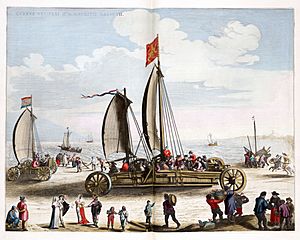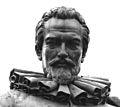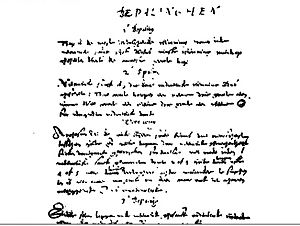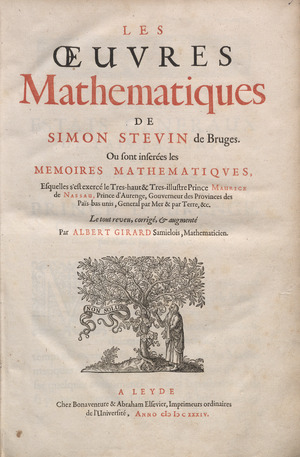Simon Stevin facts for kids
Quick facts for kids
Simon Stevin
|
|
|---|---|
 |
|
| Born | 1548 Bruges, Belgium
|
| Died | 1620 (aged 71–72) The Hague?
|
| Alma mater | Leiden University |
| Occupation |
|
| Known for | Decimal fractions Delft tower experiment Intermediate value theorem Stevin's law |
Simon Stevin (1548–1620) was a brilliant Flemish mathematician, scientist, and music expert. He was also known as Stevinus. He made many important discoveries and inventions in science and engineering.
Stevin loved the Dutch language. He even changed many math and science words into Dutch. For example, the Dutch word for mathematics, wiskunde, means "the knowledge of what is certain." This was special because most European languages used words borrowed from Greek. He also changed the Dutch word for chemistry, chemie, to scheikunde, meaning "the art of separating."
Contents
Simon Stevin's Life Story
We don't know much for sure about Simon Stevin's life. His exact birth date and the date and place of his death are not certain. We think he was born in Bruges, Belgium. This is because he signed up at Leiden University as "Simon Stevin from Bruges."
His mother, Cathelijne, came from a rich family in Ypres. Her father was a wealthy citizen of Bruges. Cathelijne later married Joost Sayon, who worked with carpets and silk. Simon Stevin was likely raised in the Calvinist faith, a type of Protestantism. It is believed that Stevin grew up in a well-off family and had a good education. He probably went to a school in his hometown where he learned Latin.
Stevin's Early Travels
Stevin left Bruges in 1571. He was probably a Calvinist, and he might have left to escape religious problems from the Spanish rulers. Some people think he first moved to Antwerp, where he worked for a merchant. Biographers say he traveled to places like Prussia, Poland, Denmark, Norway, and Sweden between 1571 and 1577.
In 1577, Simon Stevin returned to Bruges. He became an official for the city, a job he held until 1581. He worked in the office of Jan de Brune. It's not clear why he came back to Bruges. At that time, Bruges had strong religious conflicts. Catholics and Calvinists often fought for control of the city. Sometimes, they worked together against the rules of King Philip II of Spain. In 1576, some religious tolerance was allowed, which might be why Stevin returned.
Life in the Netherlands
In 1581, Stevin left Bruges again and moved to Leiden in the Netherlands. He went to a Latin school there. On February 16, 1583, he joined Leiden University. This university was started by William the Silent in 1575. At the university, he became friends with Prince Maurice, who was William the Silent's son. Stevin was at the university until 1590 but never officially graduated.
After William the Silent passed away, Prince Maurice took over. Stevin became Prince Maurice's main advisor and teacher. Prince Maurice often asked Stevin for his advice. He also gave Stevin important jobs. Stevin became the director of "waterstaet" (the government group for water management) in 1592. Later, he became the quartermaster-general of the army. Prince Maurice also asked Stevin to start an engineering school at Leiden University.
Stevin moved to The Hague and bought a house in 1612. He got married around 1610 or 1614 and had four children. He passed away in Leiden or The Hague in 1620, leaving behind his wife and two children.
-
A statue of Simon Stevin in Bruges.
-
A detail from the statue showing Stevin's inclined plane diagram.
Amazing Discoveries and Inventions

Stevin made many important discoveries and inventions. He was a leader in developing and using science in engineering. This included mathematics, physics, and practical fields like hydraulic engineering (managing water) and surveying (measuring land).
For a long time, people thought Stevin invented decimal fractions. But in the mid-20th century, researchers found that decimal fractions were used earlier by the Islamic scholar al-Uqlidisi in 952. Also, Al-Kashi wrote about them in 1427. However, Stevin helped make them widely known and used in Europe.
His friends were very impressed by his invention of a land yacht. This was a carriage with sails! A model of it was kept in Scheveningen until 1802. Around 1600, Stevin, Prince Maurice, and 26 others used the real carriage on the beach. It was powered only by wind and could go faster than horses!
Managing Waterways
Stevin's work in water management involved improving sluices and spillways. These are structures that help control flooding. He also worked on hydraulic engineering. Windmills were already used to pump water out of low-lying lands called polders. In his book Van de Molens (On mills), he suggested ways to make windmills better. He thought the wheels should move slowly with improved gear teeth. These changes made windmills three times more efficient at pumping water. He received a patent for his idea in 1586.
Stevin's Ideas on Science and Language
Stevin believed that humanity could regain all its old knowledge. He thought the best language for this would be Dutch. He showed that Dutch could express more ideas with short, one-syllable words than other European languages. This is why he wrote all his works in Dutch. He wanted his books to be useful to people who didn't know Latin, which was the common language for science at the time.
Thanks to Simon Stevin, the Dutch language got its own scientific words. For example:
- "wiskunde" for mathematics (meaning "art of what is certain")
- "natuurkunde" for physics (meaning "art of nature")
- "scheikunde" for chemistry (meaning "art of separation")
- "sterrenkunde" for astronomy (meaning "art of stars")
- "meetkunde" for geometry (meaning "art of measuring")
Geometry, Physics, and Angles

Stevin was the first to show how to draw regular and semiregular polyhedra (3D shapes with flat faces) by outlining their shapes on a flat surface. He also figured out the difference between stable and unstable balances.
He added to the study of trigonometry (the math of triangles) with his book, De Driehouckhandel.
In one of his books, he explained how forces balance on inclined planes (slopes). He used a diagram with a "wreath" of evenly spaced round weights on a triangular prism. He showed that the weights needed to balance were related to the lengths of the sides they rested on. This idea is known as the "Epitaph of Stevinus."
Stevin also discovered the hydrostatic paradox. This means that the pressure in a liquid only depends on its height, not on the shape of the container or the size of its bottom. He also figured out how to measure the pressure on any part of a container's side.
He was the first to explain tides by using the idea of the Moon's pull.
In 1586, he did an experiment in Delft. He showed that two objects of different weights fall at the same speed.
Music Theory
Simon Stevin wrote an unfinished book called Van de Spiegheling der singconst (around 1605). In this book, he talked about "equal temperament" in music. This is a way of tuning musical instruments so that all the half-steps are exactly the same size. This idea was later published in 1884. He might have been inspired by the Italian lute player and music expert Vincenzo Galilei, who was the father of Galileo Galilei.
Bookkeeping Methods
Stevin might have known about double-entry bookkeeping, a system where every financial transaction is recorded in at least two accounts. He worked as a clerk in Antwerp when he was younger. He was the first to suggest using impersonal accounts for a country's finances. He put this into practice for Prince Maurice and suggested it to the French statesman Sully.
Decimal Numbers
Stevin wrote a short book called De Thiende ("the art of tenths") in 1585. It was translated into French as La Disme. The English title was Decimal arithmetic. This book taught how to do all calculations using whole numbers without fractions. It covered addition, subtraction, multiplication, and division.
Muslim mathematicians were the first to use decimals widely. Al-Kashi's book, Key to Arithmetic, written in the early 15th century, helped spread the use of decimals. But Stevin helped make them part of everyday use in Europe. He thought this idea was so important that he believed using decimal money, measurements, and weights was only a matter of time.
Stevin's way of writing decimals was a bit complicated. He put small circles around the numbers that showed the power of one-tenth. For example, he might write 3.14 as 3⓪ 1① 4②. The decimal point we use today was probably invented by Bartholomaeus Pitiscus in 1612 and later used by John Napier.
Stevin also wrote about other science topics like optics (light), geography, and astronomy. Some of his writings were translated into Latin. Two full collections of his works were printed in French in Leiden, one in 1608 and another in 1634.
Mathematics
Stevin wrote his Arithmetic in 1594. In this book, he presented a general way to solve the quadratic equation for the first time in the Western world. This solution had been known in India almost a thousand years earlier by Brahmagupta.
According to Bartel Leendert van der Waerden, Stevin helped change how people thought about numbers. Before him, "numbers" often meant only whole numbers or fractions. Stevin helped show that real numbers form a continuous line. His idea of a real number was accepted by later scientists. Stevin also proved the intermediate value theorem for polynomials. This theorem helps find where a function crosses the x-axis. He used a "divide and conquer" method, splitting intervals into ten equal parts. Stevin's work on decimals also inspired Isaac Newton's work on infinite series.
New Words for Dutch
Stevin believed the Dutch language was great for writing about science. He translated many math terms into Dutch. Because of him, Dutch is one of the few Western European languages with many math words that don't come from Greek or Latin. This includes the name wiskunde for mathematics itself.
He wanted scientific language to be the same as the language used by everyday workers. In his book De Thiende, he wrote: "Simon Stevin wishes the stargazers, surveyors, carpet measurers, body measurers in general, coin measurers and tradespeople good luck." He also wrote that his text "teaches us all calculations that are needed by the people without using fractions. One can reduce all operations to adding, subtracting, multiplying and dividing with integers."
Some of the words he invented are still used today:
- 'aftrekken' (subtract)
- 'delen' (divide)
- 'menigvuldigen' became 'vermenigvuldigen' (multiply)
- 'vergaderen' (gathering) became 'optellen' (add, meaning "count up")
Another example is the Dutch word for diameter: 'middellijn', which literally means "line through the middle."
Some of his words, like 'teerling' for "cube" (meaning "die"), are not used in modern math Dutch, but his books were very popular.
Fun Facts
- The mechanical engineering student group at the Eindhoven University of Technology is named W.S.V. Simon Stevin. Their bar is called "De Weeghconst," and they have their own fleet of land yachts!
- Stevin, called Stevinus, is a favorite author of Uncle Toby Shandy in Laurence Sterne's book The Life and Opinions of Tristram Shandy Gentleman.
- A famous quote from Stevin is: A man in anger is no clever dissembler.
- In Bruges, there is a Simon Stevin Square with a statue of Stevin made by Eugène Simonis. The statue includes his famous inclined plane diagram.
- There is a survey vessel called RV Simon Stevin that operates from the port of Ostend. It is named after him.
See also
 In Spanish: Simon Stevin para niños
In Spanish: Simon Stevin para niños








